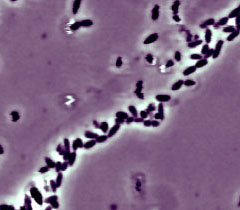This strain is known by many names. Originally is was described as Pseudomonas cepacia and later, in succession, Burkholderia cepacia, Burkholderia spp., Burkholderia fungorum and now, the first time that its validly described, as Burkholderia xenovorans (Goris et.al., 2004). The original strain is deposited in the USDA ARS Culture Collection in Peoria, Ill, under its patent collection, Accession no. NRRL B-18064. This clone was the one sequenced. We do know the genome does exhibit transpositions readily in culture. References: Bedard, D.L., R Unterman, L H Bopp, M J Brennan, M L Haberl, and C Johnson. 1986. Rapid assay for screening and characterizing microorganisms for the ability to degrade polychlorinated biphenyls. Appl. Environ. Microbiol. 51:761–768. Denef, V.J., J. Park, T.V. Tsoi, J.-M. Rouillard, H. Zhang, J.A. Wibbenmeyer, W. Verstraete, E. Gulari, S.A. Hashsham, and J.M. Tiedje. 2004. Biphenyl and benzoate metabolism in a genomic context: Outlining genome-wide metabolic networks in Burkholderia xenovorans LB400. Appl. Environ. Microbiol. 70:4961-4970. Goris, Johan, Paul De Vos, Jesús Caballero-Mellado, Joon-Hong Park, Enevold Falsen, James M. Tiedje, and Peter Vandamme. Classification of the PCB- and biphenyl degrading strain LB400 and relatives as Burkholderia xenovorans sp. nov. Intl J. Syst Evol Microbiol. 54:1677-1681. (2004). |
||
|
||
Burkholderia xenovorans LB400

